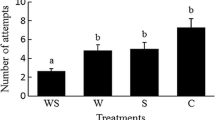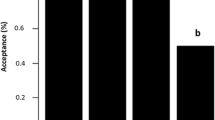Abstract
We used a video imaging technique to test the effects of prey movement on attack behavior and foraging patch residence time decision rules of wolf spiders. TwelveSchizocosa ocreata (Hentz) (Lycosidae) were tested in an artificial foraging patch stimulus chamber consisting of a microscreen television displaying a computer digitized, animated image of a cricket. Four prey movement treatments were used: (1) a blank screen, (2) a stationary cricket control, (3) a cricket moving for 1 min, and (4) a cricket moving for 10 min. Spiders stayed significantly longer in treatments with higher cricket activity. Spiders also stayed longer when they attacked the stimulus than when they did not. The distribution of patch residence times of spiders indicates a decision rule based on a fixed probability of leaving.
Similar content being viewed by others
References
Abrahams, M. V. (1986). Patch choice under perceptual constraints: A cause for departures from an ideal free distribution.Behav. Ecol. Sociobiol. 19: 409–415.
Bell, W. J. (1991).Searching Behaviour: The Behavioural Ecology of Finding Resources, Champman and Hall, London.
Charnov, E. L. (1976). Optimal foraging, the marginal value theorem.Theor. Pop. Biol. 9: 129–136.
Clark, D. L., and Uetz, G. W. (1990). Video image recognition by the jumping spider,Maevia inclemens (Araneae: Salticidae).Anim. Behav. 40: 884–890.
Clark, D. L., and Uetz, G. W. (1992). Morph-independent mate selection in a dimorphic jumping spider: Demonstration of movement bias in female choice using video-controlled courtship behaviour.Anim. Behav. 43: 247–254.
Clark, D. L., and Uetz, G. W. (1994). Signal efficacy and the evolution of male dimorphism in the jumping spider,Maevia inclemens.Proc. Natl. Acad. Sci. 90: 11954–11957.
Ford, M. J. (1978). Locomotory activity and the predation strategy of the wolf-spiderPardosa amentata (Clerck) (Lycosidae).Anim. Behav. 35: 453–461.
Giulio, L. (1979). Optomotor responses of the jumping spiderHeliophanus muscorum Walck. (Araneae Salticidae) elicited by turning spiral.Monitore Zool. Ital. (N.S.) 13: 143–157.
Heinrich, B. (1983). Do bumblebees forage optimally, and does it matter?Am. Zool. 23: 273–281.
Hodge, M. A. (1987). Factors influencing web site residence time of the rob weaing spider,Micrathena gracilis.Psyche 94: 363–371.
Janetos, A. C. (1982a). Foraging tactics of two guilds of web-spinning spiders.Behav. Ecol. Sociobiol. 10: 19–27.
Janetos, A. C. (1982b). Active foragers vs. sit-and-wait predators: a simple model.J. Theor. Biol. 95: 381–385.
Janetos, A. C., and Cole, B. J. (1981). Imperfectly optimal animals.Behav. Ecol. Sociobiol. 9: 203–209.
Kareiva, P., Morse, D. H., and Eccleston, J. (1989). Stochastic prey arrivals and crab spider giving-up times: Simulations of spider performance using two simple “rules of thumb.”Oecologia 78: 547–549.
Kennedy, M., and Gray, R. D. (1993). Can ecological theory predict the distribution of foraging animals? A critical analysis of experiments on the ideal free distribution.Oikos 68: 158–166.
Land, M. F. (1972). Stepping movements made by jumping spiders during mediated by the lateral eyes.J. Exp. Biol. 57: 15–40.
Land, M. F. (1971). Orientation by jumping spiders in the absence of visual feedback.J. Exp. Biol. 54: 119–139.
McClintock, W. J., and Uetz, G. W. (1996). Female choice and preexisting bias: Visual cues during courtship in twoSchizocosa wolf spiders (Araneae: Lycosidae).Anim. Behav. 52: 167–181.
Morse, D. H. (1993). Choosing hunting sites with little information: Patch-choice responses of crab spiders to distant cues.Behav. Ecol. 4: 61–65.
Nishimura, K. (1994). Decision making of a sit-and-wait forager in an uncertain environment: Learning and memory load.Am. Nat. 143: 656–676.
Olive, C. W. (1982). Behavioral response of a sit-and-wait predator to spatial variation in foraging gain.Ecology 63: 912–920.
Pasquet, A., Ridwan, A., and LeBorgne, R. (1994). Presence of potential prey affects web-building in an orb-weaving spiderZygiella x-notata.Anim. Behav. 47: 477–480.
Persons, M. H., and Uetz, G. W. (1996a). The influence of sensory information on patch residence time in wolf spiders (Araneae: Lycosidae).Anim. Behav. 51: 1285–1293.
Persons, M. H., and Uetz, G. W. (1996b). Wolf spiders vary patch residence time in the presence of chemical cues from prey (Araneae: Lycosidae).J. Arachnol 24: 76–79.
Persons, M. H., and Uetz, G. W. (1997). Residence time decisions in wolf spiders: is perceiving prey as important as eating prey?Ecoscience 4: 1–5.
Pyke, G. H. (1984). Optimal foraging theory: A critical review.Annu. Rev. Ecol. Syst. 15: 523–575.
Pyke, G. H., Pulliam, H. R., and Charnov, E. L. (1977). Optimal foraging: a selective review of theory and tests.Q. Rev. Biol. 52: 137–154.
Riechert, S. E. (1985). Decisions in multiple goal contexts: Habitat selection of the spider,Agelenopsis aperta (Gertsch).Z. Tierpsychol. 70: 53–69.
Rovner, J. S. (1991). Evidence for idiothetically controlled turns and extraocular photoreception in lycosid spiders.J. Arachnol. 19: 169–173.
Rovner, J. S. (1993). Visually mediated responses in the lycosid spiderRabidosa rabida: The roles of different pairs of eyes.Mem. Queensland Mus. 33: 635–638.
Schoener, T. W. (1971). Theory of feeding strategies.Annu. Rev. Ecol. Syst. 2: 369–404.
Seyfarth, E., Hergenroder, R., Ebbes, H., and Barth, F. G. (1982). Idiothetic orientation of a wandering spider: Compensation of detours and estimates of goal distance.Behav. Ecol. Sociobiol. 11: 139–148.
Stephens, D. W., and Krebs, J. R. (1986).Foraging Theory, Princeton University Press, Princeton, NJ.
Suter, R. B., and Sanchez, E. (1991). Evolutionary stability of stochastic decision making in spiders: Results of a simulation.Anim. Behav. 42: 921–929.
Suter, R. B., and Walberer, L. (1989). Enigmatic cohabitation in bowl and doily spiders,Frontinella pyramitela (Araneae, Linyphiidae).Anim. Behav. 37: 402–409.
Uetz, G. W. (1992). Foraging strategies of spiders.Trends Ecol. Evol. 7: 155–159.
Valone, T. J. (1991). Bayesian and prescient assessment: foraging with pre-harvest information.Anim. Behav. 41: 569–577.
Vollrath, R. (1985). Web spider’s dilemma: A risky move or site dependent growth.Oecologia 68: 69–72.
Wise, D. H. (1993).Spiders in Ecological Webs, Cambridge University Press, Cambridge.
Zar, J. H. (1984).Biostatistical Analysis, 2nd ed., Prentice-Hall, Englewood Cliffs, NJ.
Author information
Authors and Affiliations
Rights and permissions
About this article
Cite this article
Persons, M.H., Uetz, G.W. The effect of prey movement on attack behavior and patch residence decision rules of wolf spiders (Araneae: Lycosidae). J Insect Behav 10, 737–752 (1997). https://doi.org/10.1007/BF02765390
Revised:
Issue Date:
DOI: https://doi.org/10.1007/BF02765390




